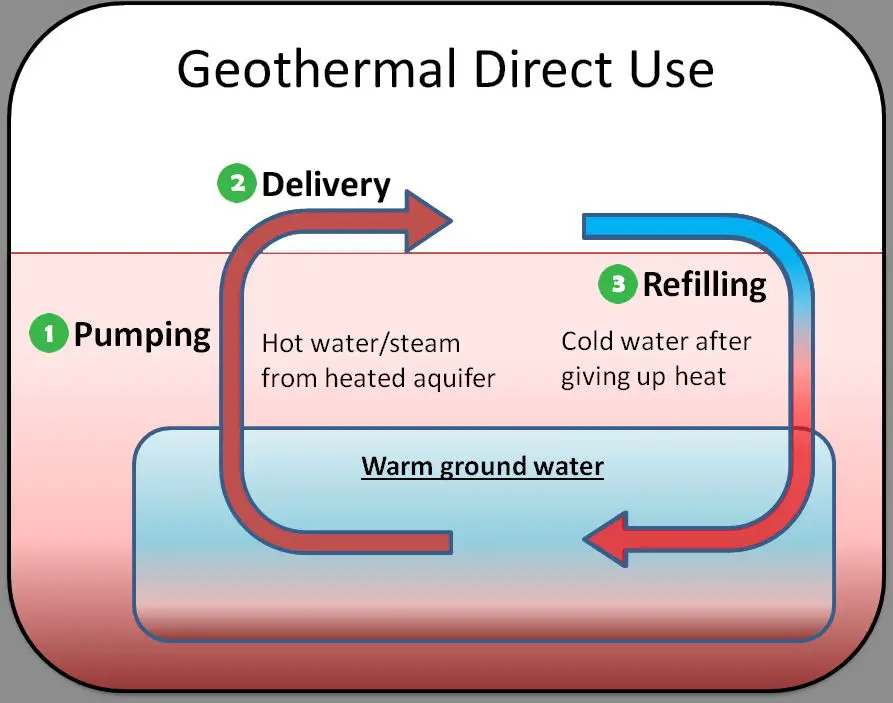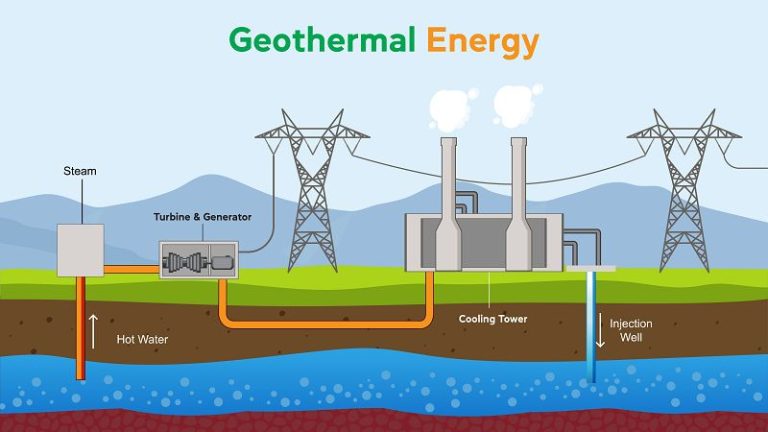What Is Geothermal Energy Being Used Directly To Generate?
What is Geothermal Energy?
Geothermal energy is thermal energy generated and stored in the Earth (U.S. Energy Information Association, 2023). It arises from the original formation of the planet, from radioactive decay of minerals, and from solar energy absorbed at the surface (U.S. Department of Energy, 2023). Geothermal energy is considered a renewable energy source because the heat emanating from the interior of the Earth is continuously replenished.
People have utilized geothermal energy for bathing and heating since Paleolithic times. The oldest known spa is a hot spring in Bath, England, that was used by the Romans in 43 AD (TWI Global, 2023). More recently in 1904, the first geothermal power plant was built in Tuscany, Italy to generate electricity. By the 1970s, geothermal power plants were operating in the United States at The Geysers in northern California.
Today, geothermal energy is used worldwide for heating buildings, growing plants in greenhouses, drying crops, heating water at fish farms, and several other direct uses. It is also used at geothermal power plants in some locations to produce electricity.
Types of Geothermal Energy Resources
There are three main types of geothermal energy resources that can be used to generate electricity:
Hydrothermal Resources – These resources contain hot water or steam reservoirs found beneath the earth’s surface. The heated water can reach temperatures greater than 350°F (177°C). Hydrothermal resources are the most common type used for geothermal power generation. They use steam or hot water from the reservoir to spin turbines and generate electricity. Examples include The Geysers in California and the Larderello field in Italy.
Geo-pressured Resources – These geothermal resources contain hot brine reservoirs. They are found deep underground and are under abnormal pressure. The high pressure allows brine temperatures to reach 400°F (205°C) or beyond. Geo-pressured reservoirs have not yet been used on a commercial scale for power generation [1].
Hot Dry Rock Resources – Also known as enhanced geothermal systems (EGS), these resources lack natural water or steam and require hydraulic fracturing. Water is injected into the hot dry rocks found deep beneath the earth’s surface. The heated water is then pumped back up to the surface where it vaporizes to steam. The steam can then spin turbines to generate electricity [2].
Direct Uses of Geothermal Energy
Geothermal energy can be used directly for a variety of applications including space heating and cooling, food dehydration, greenhouses, and industrial processes. The direct use of geothermal energy takes advantage of the heat contained in geothermal reservoirs to provide thermal energy for these applications without first converting it into electricity.

One of the most common direct uses is for space heating and cooling. Geothermal heat pumps can tap into shallow ground or water temperatures to efficiently heat and cool buildings. This accounts for the largest share of geothermal direct use worldwide (NREL, 2004).
Food dehydration is another major direct use of geothermal energy. The heat is used to remove moisture from vegetables, fruits, and herbs to produce dried products. Countries like China, France, and Iceland use geothermal heat for food dehydration purposes (WBDG, 2016).
Greenhouses also utilize geothermal energy for heating and humidity control. The warm water can help regulate the temperature for optimum plant growth. Geothermal greenhouses are popular in countries with cold winters like Iceland, New Zealand, and Russia.
Finally, geothermal energy can provide process heat for industrial applications like aquaculture, milk pasteurization, gold mining, and laundries. The direct heat substitutes for grid electricity or fossil fuels in these processes.
Geothermal Power Generation
Geothermal energy can be harnessed to generate electricity in power plants. There are three main types of geothermal power plants:
- Flash steam power plants – These use geothermal reservoirs of water with temperatures greater than 360°F (182°C). The hot water flows up through wells in the ground under its own pressure. As it flows upward, the pressure decreases and some of the hot water boils into steam. The steam is then separated from the water and used to power a turbine/generator.
- Dry steam power plants – These use geothermal reservoirs of steam. The steam goes directly through pipelines to power a turbine/generator.
- Binary cycle power plants – These use geothermal reservoirs of water with moderate temperatures of about 225-360°F (107-182°C). The hot water is passed through a heat exchanger, which transfers the heat to a secondary (binary) fluid with a much lower boiling point than water. This causes the binary fluid to flash to vapor, which then drives a turbine.
The United States leads the world in geothermal power capacity and generation. In 2021, geothermal power plants in the U.S. had an installed nameplate capacity of 3.8 GW and produced about 16 billion kWh of electricity, according to the Department of Energy.
Benefits of Geothermal Energy
Geothermal energy provides several key benefits that make it an attractive renewable energy source:
Renewable and Sustainable – Geothermal energy is considered renewable and sustainable. The Earth’s geothermal energy originates from heat within the Earth’s core and will be available for the foreseeable future as a clean energy source.
Reduces Reliance on Fossil Fuels – Using geothermal energy can reduce reliance on fossil fuels like coal and natural gas that produce greenhouse gas emissions when burned. Geothermal provides a clean alternative for electricity generation.
Low Emissions – Geothermal power plants emit on average 1/6th of the carbon dioxide of a relatively clean natural gas-fueled power plant per kilowatt-hour generated. The emissions are low since no fuel needs to be burned.
Reliable Baseload Power – Geothermal plants offer a reliable source of baseload power since they can operate continuously without disruption. This makes geothermal a stable and consistent energy solution.
Sources: https://www.enelgreenpower.com/learning-hub/renewable-energies/geothermal-energy/advantages
Limitations of Geothermal Energy
While geothermal energy has many benefits, it also has some limitations that restrict its wider adoption. Some of the main limitations of geothermal energy include:
High Upfront Costs
Constructing a geothermal power plant requires a large upfront capital investment. Drilling wells thousands of feet into the earth and installing pipes and turbines is expensive. The initial costs for geothermal plants are estimated to be around $2-4 million per megawatt of generating capacity, higher than other renewable sources like wind and solar power.
Limited to Geographical Locations
Geothermal energy can only be harnessed in areas with suitable underground heat and water resources, such as along tectonic plate boundaries, hot spots, and volcanically active locations. This restricts widespread adoption since geothermal sources are not evenly distributed geographically.
Potential Emissions Without Abatement
While geothermal energy itself is clean, geothermal reservoirs can contain gases like carbon dioxide, hydrogen sulfide, ammonia, and methane that are released during drilling and power generation. Proper abatement technology is needed to limit emissions and prevent pollution.
Land Subsidence Risks
Extracting large amounts of geothermal fluids from reservoirs can cause land subsidence, or ground sinking, damaging infrastructure if not properly managed. Careful reservoir management is needed to avoid depleting resources and destabilizing the land.
Despite these limitations, geothermal remains an important renewable energy source with substantial potential in suitable locations. Ongoing technological improvements and careful resource management can help address some of its current drawbacks.
Global Geothermal Energy Use
The top countries utilizing geothermal energy for power generation in 2022 were the United States, Indonesia, Philippines, Turkey, and Kenya [1]. The United States led with nearly 4,000 MW of installed capacity, followed by Indonesia with 2,418 MW. Other major geothermal energy producers include New Zealand, Mexico, Italy, and Iceland.
In 2022, global geothermal power generation capacity grew by 199 MW across 8 countries. The countries adding the most new capacity were Kenya (83 MW), Indonesia (80 MW), and the United States (26 MW) [2]. Overall, the global geothermal market continues to expand steadily, with particular growth in developing economies.
Projections indicate the Asia-Pacific region will see the fastest growth in geothermal capacity through 2027, followed by Africa and Central and South America. Countries such as Kenya, Ethiopia, and Indonesia have major geothermal expansions planned. The global geothermal power market is forecast to reach nearly 18 GW by 2027.
Geothermal Energy in the United States
The United States leads the world in installed geothermal capacity, with around 3,700 MW as of 2021 1. The western states, where most high-temperature geothermal resources are located, have the majority of geothermal power plants. California has the most geothermal capacity at 2,730 MW, followed by Nevada at 1,500 MW 2. Other leading geothermal states include Utah, Hawaii, Idaho and Oregon.
The Geysers in California is the largest geothermal field in the world with 15 power plants generating over 700 MW. Other major geothermal resource areas include the Coso Volcanic Field and Salton Sea in California, Steamboat Springs in Nevada, and Roosevelt Hot Springs in Utah 3.
Several policies and incentives at the federal and state level aim to promote geothermal development in the U.S. These include the federal production tax credit, grants and loan guarantees from the Department of Energy, and renewable portfolio standards in leading geothermal states.
Future of Geothermal Energy
Geothermal energy has significant potential for growth in the coming years, thanks to technological advances and innovative systems. According to research from MIT, enhanced geothermal systems (EGS) could provide 100 gigawatts of electricity in the United States by 2050, meeting around 10% of the nation’s energy needs.1 EGS involves drilling deeper wells and engineering underground reservoirs to extract heat from dry hot rocks. This expands the potential for geothermal energy beyond conventional hydrothermal resources.
Co-production of geothermal energy with oil and gas drilling is another promising approach. By using the hot wastewater brought to the surface during fossil fuel extraction, binary power plants can generate electricity without separate wells or reservoirs. The Department of Energy estimates there is enough coproduced hot water for 60 gigawatts of capacity in the U.S.2 This hybrid model allows for geothermal development with reduced costs and impacts.
Hybrid power plants that combine geothermal, solar, and/or wind resources are also gaining interest. By balancing intermittent renewable sources with the constant baseline power of geothermal, these plants can provide reliable clean energy around the clock. The flexibility of hybrid systems will help expand geothermal’s role in the global energy transition.
Key Takeaways
Geothermal energy refers to the heat within the Earth that can be harnessed for direct use or to generate electricity. There are different types of geothermal resources, including hydrothermal reservoirs and hot dry rock.
One of the most common direct uses of geothermal energy is for heating and cooling buildings with geothermal heat pumps. Geothermal energy is also used to heat water at spas and to heat greenhouses and aquaculture ponds.
Geothermal power plants use hydrothermal resources with high temperatures (above 150°C) to produce electricity. Hot water or steam from geothermal reservoirs spins a turbine that activates a generator, which produces electricity. Geothermal power accounts for about 0.3% of total U.S. electricity generation.
Generating electricity from geothermal resources has several benefits, including providing constant baseload power, reducing reliance on fossil fuels, and emitting little to no greenhouse gases. However, geothermal power development can be constrained by upfront costs and suitable subsurface resources.
Global geothermal power capacity is about 15 GW and is expected to grow substantially as technology improves and more resources are tapped. The western U.S. has the most geothermal power plants, but potential exists in many other parts of the country.


